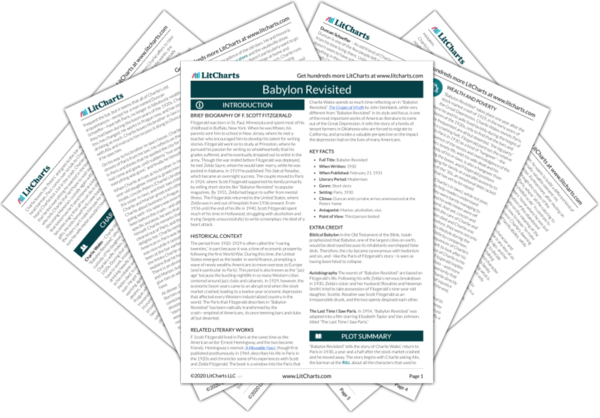Welcome to the LitCharts study guide on F. Scott Fitzgerald's Babylon Revisited. Created by the original team behind SparkNotes, LitCharts are the world's best literature guides.
Babylon Revisited: Introduction
Babylon Revisited: Plot Summary
Babylon Revisited: Detailed Summary & Analysis
Babylon Revisited: Themes
Babylon Revisited: Quotes
Babylon Revisited: Characters
Babylon Revisited: Symbols
Babylon Revisited: Theme Wheel
Brief Biography of F. Scott Fitzgerald

Historical Context of Babylon Revisited
Other Books Related to Babylon Revisited
- Full Title: Babylon Revisited
- When Written: 1930
- When Published: February 21, 1931
- Literary Period: Modernism
- Genre: Short story
- Setting: Paris, 1930
- Climax: Duncan and Lorraine arrive unannounced at the Peters’ home
- Antagonist: Marion, alcoholism, vice
- Point of View: Third person limited
Extra Credit for Babylon Revisited
Biblical Babylon In the Old Testament of the Bible, Isaiah prophesized that Babylon, one of the largest cities on earth, would be destroyed because its inhabitants worshipped false idols. Therefore, the city became synonymous with hedonism and sin, and—like the Paris of Fitzgerald’s story—is seen as having been fated to collapse.
Autobiography The events of “Babylon Revisited” are based on Fitzgerald’s life. Following his wife Zelda’s nervous breakdown in 1930, Zelda’s sister and her husband (Rosaline and Newman Smith) tried to take possession of Fitzgerald’s nine-year-old daughter, Scottie. Rosaline saw Scott Fitzgerald as an irresponsible drunk, and the two openly despised each other.
The Last Time I Saw Paris. In 1954, “Babylon Revisited” was adapted into a film starring Elizabeth Taylor and Van Johnson, titled “The Last Time I Saw Paris.”







